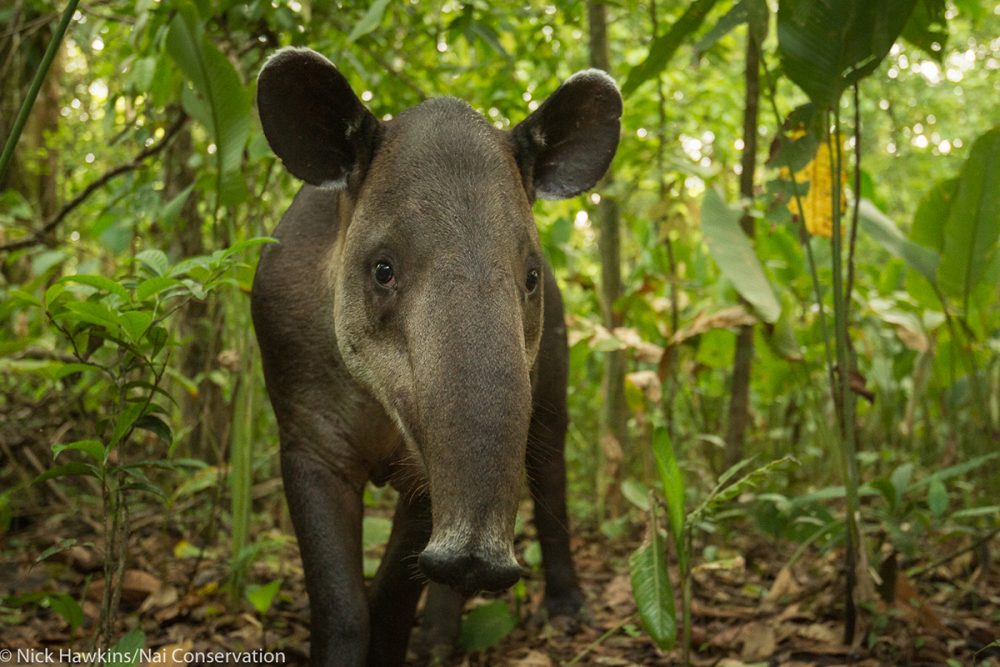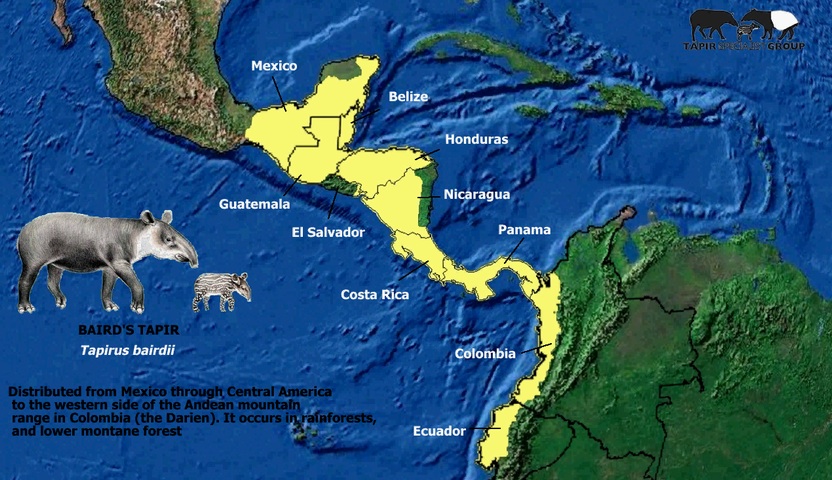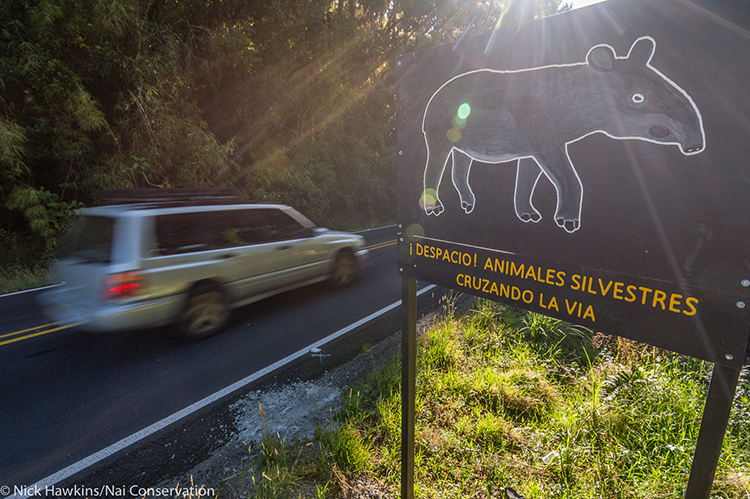By Analiese Haag
Have you heard of the “gardeners of the forest”? What about the “mountain cow” or “Central America’s diving pig”? Can you name the largest animal native to Central America, that also happens to be Belize’s national animal?
It is not an elephant, although with its uniquely long nose, it does bear some resemblance to one. Due to this species’ uneven number of toes, hooves, and unique digestive system, it is actually classified in the same family as modern horses and rhinoceroses.
Still not sure what animal this could be?
Let me introduce the Baird’s tapir (see Figure 1).

There are four species of tapirs; each one lives in a distinctive region and has a unique appearance. The Baird tapir is the largest animal native to Central America. They can grow up to five feet tall and reach 550 pounds (3). A short brown coat covers its thick tough hide with a dark spot on each cheek and cream-colored marks on its throat, face, and tips of its ears. Like all tapirs, they have a tube-like nose known as a prominent proboscis. This organ is made of soft tissue, making it highly flexible to be used as a snorkel underwater or to grab edible leaves and stems (2). Baird tapirs are agile animals, easily climbing mountains, running, and swimming. Except for mothers and their young, tapirs do their travels alone. When our class Talking Science in Costa Rica was hiking the Barva Volcanos, we noticed a blurry figure hurrying across the path. Given the general size, colorization, speed, and the fact that this animal was alone, we believed we saw the amazing Baird tapir!
Within Southern Mexico, Belize, Honduras, Nicaragua, the Republic of Panama, north-western Colombia, Guatemala, and Costa Rica, the Baird tapir lives in various zones (see Figure 2): marsh areas, flooded grasslands, rainforests, lower montane forests, and deciduous forests.The tapir uses different aspects of these ecosystems to its advantage. They use water sources to escape predictors, eat aquatic plants, wash off ticks, and cool down. Meanwhile, wooded and grassy areas provide shelter during the day and fulfill their nutritional needs. Baird’s tapirs are large herbivores, so they need to eat a lot of plants. This gives them the capacity to eat and disperse two hundred different plant species- making them an integral species for the overall health of an ecosystem. They eat the larger seeds that many other species can not eat, which often gives rise to trees with dense wood and a high carbon sequestering and fixation capacity. When the seeds enter the animal’s digestive tract, they are exposed to acids and high temperatures, increasing the chances of the seed successfully sprouting. They can also eat plants that would harm other species since they do not absorb some plant toxins. Moreover, they travel long distances on their mountain exhibitions like those in the Talamanca (Costa Rica) mountain range. This increases the potential scope of growth for plants. As they migrate, tapirs clear woodland and open up trails, enabling the seeds in their feces to have prime conditions to colonize the new areas. Seventy percent of Central American tapirs are composed of bamboo, meaning they help fulfill the role of biological control so that bamboo does not crowd out other plants. By promoting biodiversity, tapirs contribute to the profitable industry of ecotourism within Costa Rica. These animals eat a lot, a large variety, digest it quickly, and pass it out on the other end. They maintain balance within their habitat. For this reason, Baird’s tapir has earned the title of a landscape architect or the “gardener of the forest.”

Despite their undeniable value, humans have failed to protect these magnificent creatures and are driving them to extinction. In the past three generations, Baird’s Tapir has decreased in population by more than fifty percent, leading to its classification as endangered and regionally extinct in El Salvador (1). Habitat loss, expanding agriculture, livestock and the spread of infectious diseases, mega-infrastructure, fires, road kills, climate change, and hunting all contribute to the decline of this species’ population (5). Because of their size this species was often hunted for food. Tapirs have a slow reproduction process (with a gestation period of around thirteen months), so hunting quickly became unsustainable. Tied with killing animals for sport or capturing them as exotic pets, humans directly contributed to the species’ demise. Furthermore, deforestation and isolation pose significant threats to the species. Approximately seventy percent of Central American forest has been lost in the past forty years. Deforestation is often driven by the agriculture industry- in particular monoculture plantations like those of palm oil- which is rapidly increasing (1). Individuals become fragmented, leading to genetic isolation. Infrastructure adds to this separation and exposes tapirs to automobiles, causing road kills to be a considerable problem (see Figure 3). Of course, anthropogenic climate change, increased droughts, extreme weather, and fires all contribute to the species’ stresses. Action must be taken to decrease the dangers that Baird’s tapirs face.

While the Baird tapir population in Costa Rica is relatively stable- due largely to the county’s emphasis on biodiversity- there are still changes that can occur within this region to help with conservation efforts. Costa Rica has implemented laws to decrease poaching and protect tapirs; however, there is room for improvement when enforcing these laws. Other nations, such as the US, can play a role by partially forgiving debt, so Costa Rica has the money to put biodiversity at the forefront. Palm oil plantations can be addressed by only giving licenses to increase agricultural practices in previously used banana cultivation regions and never resorting to deforestation (4). Current conservation efforts- like Baird’s Tapir Survival Alliance (BTSA) and the Endangered Species of Wild Fauna and Flora of the convention on International Trade (CITES) (2)- reveal that both on a national and global level, people are capable of making the necessary shifts to protect Baird’s tapir.
Sources
1)https://www.iucnredlist.org/species/pdf/45173340
2)https://www.google.com/url?sa=t&rct=j&q=&esrc=s&source=web&cd=&ved=2ahUKEwjc9K2X3bv9AhX7_rsIHTOaDPQQFnoECEMQAQ&url=https%3A%2F%2Fwww.nationalgeographic.com%2Fanimals%2Fmammals%2Ffacts%2Fbaird-s-tapir&usg=AOvVaw07IwPEfhXTmgN3126UEIFk
3)https://tapirs.org/tapirs/bairds-tapir/
4)https://news.mongabay.com/2013/10/nature-tours-in-costa-rica-an-economic-alternative-to-palm-oil/
5)https://medium.com/thebeammagazine/costa-rica-the-paris-agreement-is-unviable-without-tapirs-2172dcf1c71b
Photos
Figure 1: http://www.edgeofexistence.org/species/bairds-tapir/
Figure 2: https://tapirs.org/tapirs/bairds-tapir/
Figure 3: https://www.rewild.org/news/preserving-tapirs-in-the-mysterious-mountains-of-costa-rica